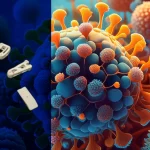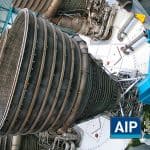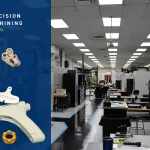The last step in finishing a part is to apply an appropriate finish. Finishing a machined part can be as simple as smoothing off the burrs and other sharp edges or painting and coating the material to improve aesthetics and functionality. In the initial design phase of your project, talk to your machinist about the finishing processes to get a highly precise and extremely resilient piece.
AIP has over 37 years of experience machining complex components from thermoplastics. In this technical blog, we discuss putting the finishing touches on your CNC machined part, including: finishing, deburring, painting and polishing.
Common Finishing Techniques for CNC Machining
As Machined
The “as machined” part is the standard finish for the material. Many times, it has visible tools marks, but it has no additional cost to the machining process. Also, this finish has the tightest dimensional tolerances. Our standard AIP machined finish has almost no tool marks – we go the extra mile for our customers to produce unparalleled results. Taking pride in our craftsmanship and attention to detail is what makes us stand out from other CNC machine shops in the industry.
Deburring
Deburring involves the removal of burrs and sharp edges. A variety of tools may be used including die grinders, deburring scrapers, files and various stones.
Painting
Painting a finished part fulfills two requirements: 1) improves appearance (aesthetics) and 2) enhances the function of the piece.
Various coatings and treatments provide protection and add color to the surface of machined parts:
- Plating: Chrome plating, nickel plating and other kinds of metal can be applied via plating processes.
- Painting: Resins generally come in many different colors and can be painted to fit the exact specifications of a project.
- Powder Coating: Powder coating adds a wear and corrosion finish to the surface of a part. It has a higher impact resistance compared to anodizing and a large range of colors are available.
- Silk Screening: This is an inexpensive way to print text or logos on the surface of a CNC machined part. The print can be applied only to external surfaces on a part.
Polishing
There are several different types of polishing to finish off a machined plastic part. Here are a few of the most common methods:
- Vibratory Polishing: This method uses rotating or vibrating tumblers along with a variety of media to deburr, remove tooling marks and polish parts. It is convenient for large bulk items that need polishing. Put them in a tumbler and go do something else.
- Bead Blasting: This process uses compressed air to blast an abrasive media at the material. This method is done inside of a blast cabinet. It adds a uniform matte or satin surface finish on a machined part and removes all tool marks.
- Filing: Filing down the edges or burrs on a small machined part is a craft, however, a good file offers efficiency. This technique is often taught to apprentice machinists.
- Stoning: Machinists use stones and oil to deburr and knock off sharp edges that tear and snag.
Case Study: Making a Splash with Machined PPS
The finishing plays a major role in the quality, durability and utility of a machined plastic part. For our client in the theme park business, it meant reducing a water ride’s overhauls by 25 times.
When a popular ride experiences downtime, the negative impact on guest satisfaction is immediate. Lost interest and value in a park experience can mean loss of customers and in effect revenue. For our Florida theme park client, this was the case with their log flume coaster ride. While this ride was thrilling for its daily customers, the ride required nightly repair and part replacement. They specifically needed new wheel bushings from a more innovative material.
Since we had worked with this client previously, we were able to assess the project. The log flume’s passenger carts originally used bronze bushings due to their nice, soft wear, however, the speed and load of the carts generated a great deal of heat when the ride would plunge into its steep vertical drop. The moment each cart hit the cool water below, the wheel bushings would suddenly experience “shock cooling” damage.
Between this and the constant exposure to chemicals in the water (chlorine), the bronze bushings had a very short life cycle.
Our team selected Quadrant’s BG1326, a bearing-grade high-performance thermoplastic PPS.
 PPS has a low moisture absorption rate and can be machined to the exact tolerances necessary for clearing and shaft. With low-wear, high temperature stability and a low coefficient of friction, the chosen PPS grade proved to be an excellent fit for the log flume’s wheel bushings.
PPS has a low moisture absorption rate and can be machined to the exact tolerances necessary for clearing and shaft. With low-wear, high temperature stability and a low coefficient of friction, the chosen PPS grade proved to be an excellent fit for the log flume’s wheel bushings.
Our machinists at AIP worked diligently with the ride engineers to ensure the PPS bushings were built to exact specifications. The chosen method for machining the parts was precision machining. This way the components could meet the precise tolerances and finishes demanded by the speed and load of the log flume.
The Benefits
The main benefit of the machined PPS bushings was the reduction in ride downtime. The previous bronze bushings required around 25 times the overhauls of the new PPS bushings. The change in materials not only saved on maintenance and inventory costs, but improved guest satisfaction with the increase in uptime.
The PPS bushings also removed the potential for grease to affect seals or chemicals in the water. As a self-lubricating plastic, PPS removed the need for nightly greasing the wheel bushings. The lower energy cost of the PPS material also made for a more environmentally friendly and efficient design.
Preventing Contamination
Some companies machine both metals and plastics, which can open the door to contamination of a product. Although some sources state that most CNC machining tools can be used for both metal machining and plastic machining, this is not recommended. Past experiences have shown parts going to customer without cracks, only to develop surface warpage and cracks over time due to exposure to metal machine shop fluids.
Mitigate contamination by working with a facility like AIP that works solely with polymers. We ensure the highest level of sanitation down to the sub-molecular level by designing, heat-treating and machining only plastics. This allows us to eliminate the risk of metallic cross contamination.
Supporting Materials
Certifications and Regulatory Resources
We promise unmatched precision and unrivaled expertise at AIP.
Learn more about our capabilities and reach out to our machinists for a consultation on your precision machined project.






